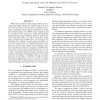Free Online Productivity Tools
i2Speak
i2Symbol
i2OCR
iTex2Img
iWeb2Print
iWeb2Shot
i2Type
iPdf2Split
iPdf2Merge
i2Bopomofo
i2Arabic
i2Style
i2Image
i2PDF
iLatex2Rtf
Sci2ools
FPL
2006
Springer
2006
Springer
Actual-Delay Circuits on FPGA: Trading-Off Luts for Speed
FPGA devices exhibit manufacturing variability. Device ratings and Timing margins are typically used in order to cope with inter-device and intra-device variability respectively. Actual-delay circuits operate according to the actual, physical device delays of the FPGA device components and not according to STA predictions, exhibit data-dependent delay,latency and output completion detection, and can thus detect when their outputs are ready to be latched. In this paper we demonstrate an FPGA flow, based around existing FPGA tools, capable of implementing actual-delay circuits, and through worst-case, upper-bound analysis show that such circuits exhibit reduced delay and higher performance than their conventional counterparts. The FPGA flow incorporates a logic synthesis transformation step for converting a conventional single-rail circuit to monotonic, dualrail and a LUT mapper for mapping the latter to LUTs while preserving monotonicity. In addition, through our implementation of actu...
Actual-delay Circuits | FPGA | FPGA Device | FPL 2006 | Hardware |
| Added | 22 Aug 2010 |
| Updated | 22 Aug 2010 |
| Type | Conference |
| Year | 2006 |
| Where | FPL |
| Authors | Evangelia Kassapaki, Pavlos M. Mattheakis, Christos P. Sotiriou |
Comments (0)

